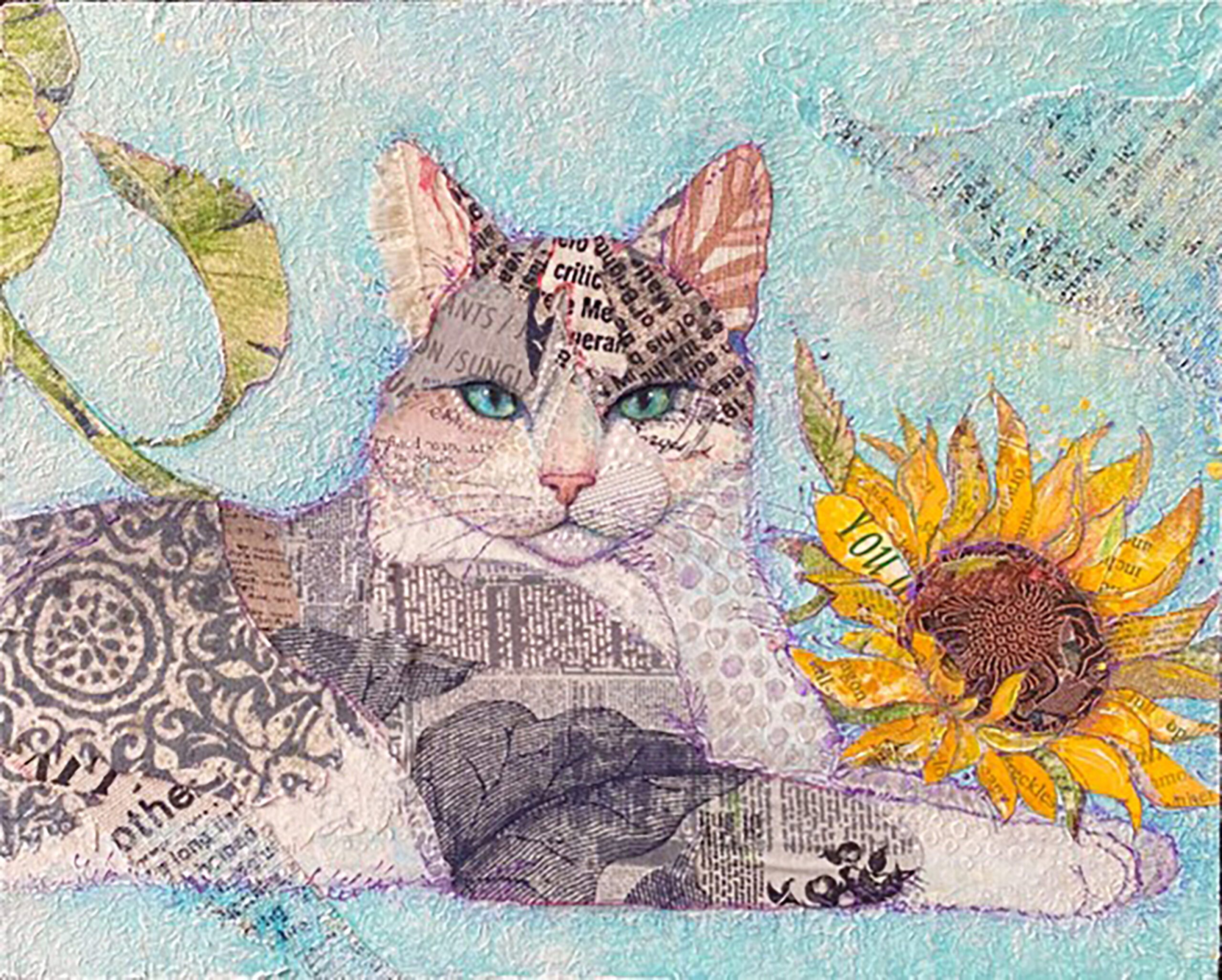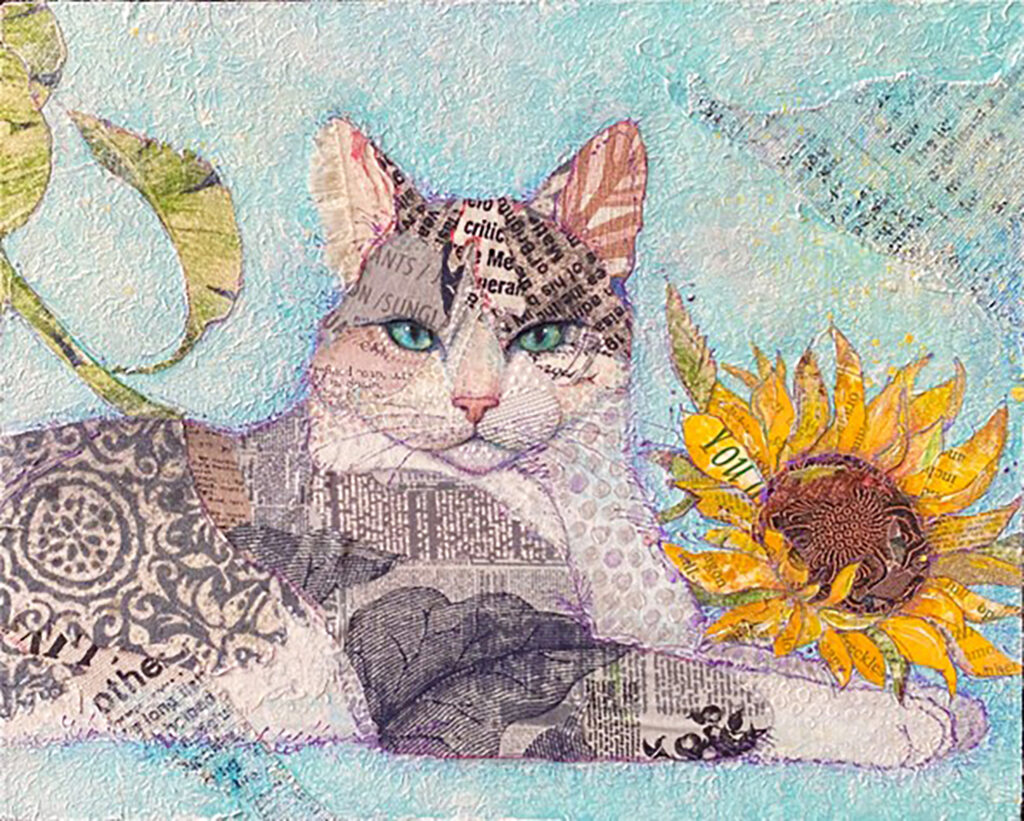
History of Cat Painting & Cat Art — The Journey of Cats and Civilization
This page explores how the cultural symbolism of cats has evolved across eras and regions through painting and visual art. Rather than treating cat art as a mere “history of beauty,” we read it as a mirror that reflects how humans relate to animals, nature, domestic life, gender, and even the sacred. From the divine guardians of ancient Egypt to the beloved internet icons of the digital age, we trace the sociological and anthropological shifts of cats in art across time and place.
Ancient Egypt: Cats as Sacred Companions and Social Order
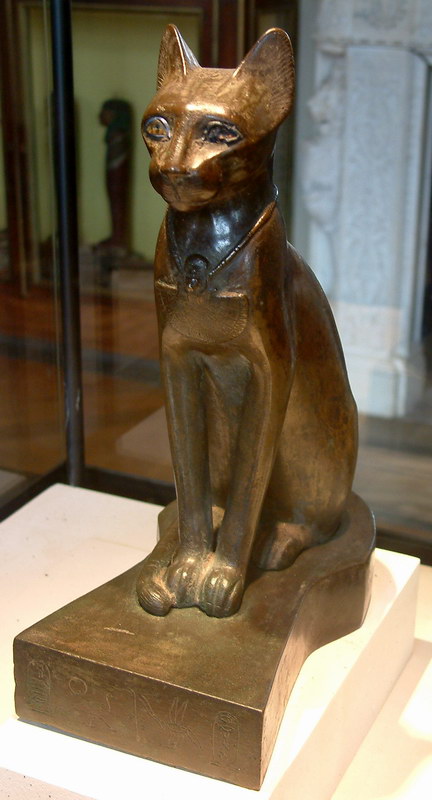
Cats’ practical role in protecting grain stores from vermin gradually took on moral and religious value and came to be regarded as sacred. They were linked to the goddess Bastet, who presides over fertility, motherhood, and domestic protection. For the people of the time, safeguarding food was tantamount to safeguarding civilization itself. Cats were honored as intermediaries between nature and human society—wild enough to control chaos, yet tame enough to live in the home. This duality is reflected in the art of the period: cats appear both as domesticated animals and as sacred symbols.
East Asia: Cats as Symbols of Harmony, Good Fortune, and Refinement
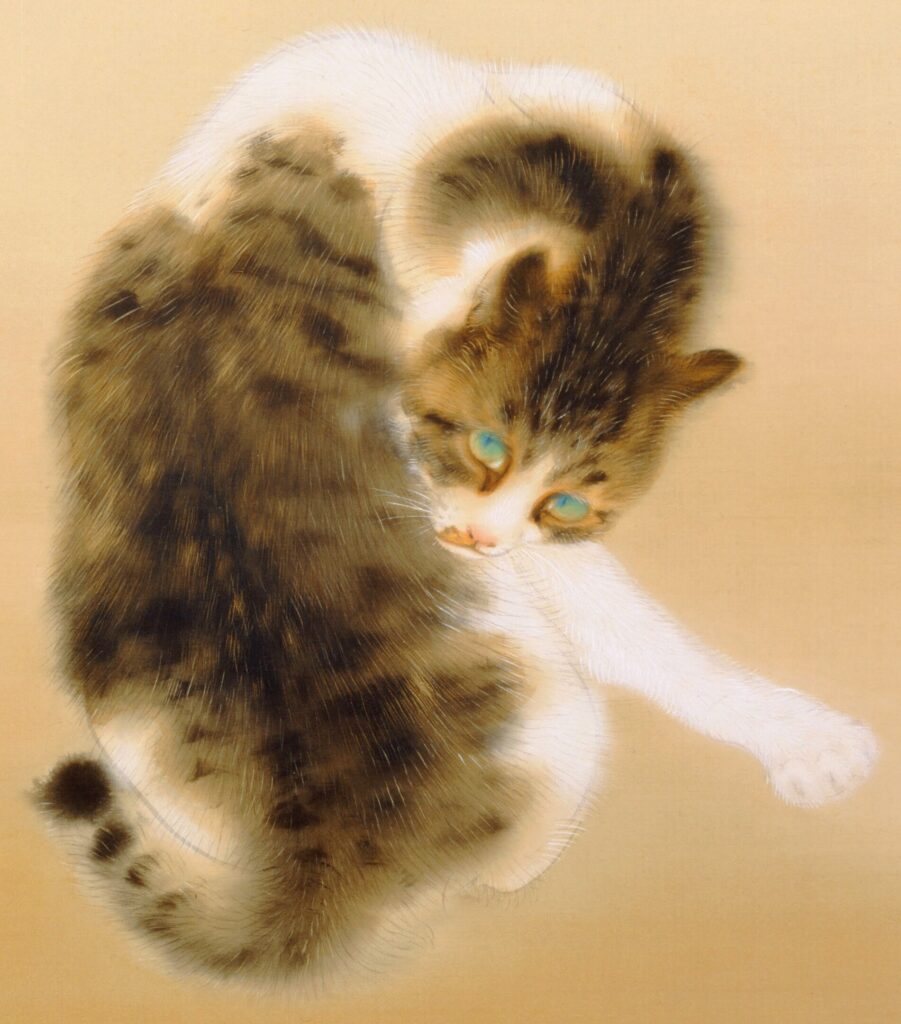
China — Han to Tang Dynasties
In China, cats symbolized yin qualities—tranquility, elegance, and delicacy. They appear in poetry and painting as the quiet companions of scholars and, in decorative arts, as auspicious charms for longevity and wealth. Across many contexts, the cat was viewed positively.
Japan — Edo Period (A Closer Look)
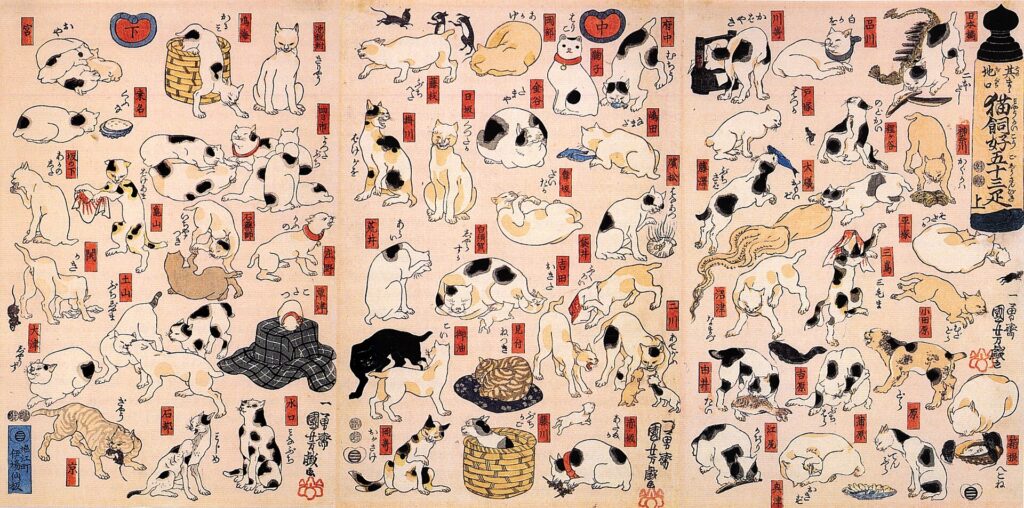
In Japan, the Maneki-Neko (Beckoning Cat) spread as a lucky charm inviting prosperity. In ukiyo-e prints, cats often appear playful and sometimes anthropomorphized, symbolizing the vibrancy of urban leisure culture. Within Shinto worldviews, cats could be both protective beings and mischievous yōkai (supernatural creatures). In East Asia, cats thus embody balance and harmony: “domestic yet free,” “fortunate yet mysterious.”
Especially the Maneki-Neko—a Japanese good-luck talisman with an adorable beckoning pose—is said to have arisen from Edo-period townspeople culture and spread nationwide.
Maneki-Neko: The Cat as a Lucky Guardian

Origins and History
The Maneki-Neko is believed to have originated in Japan during the Edo period. There are several origin stories, notably the legend associated with Gotoku-ji Temple in Tokyo and the Imado-yaki pottery “Maru-shime Neko” in Asakusa.
Meaning of the Raised Paw
Right paw: invites wealth and business prosperity.
Left paw: invites people or customers.
Both paws: protection from misfortune and safety at home.
Meaning of Colors
Calico: traditional and considered the luckiest.
Gold: financial fortune.
Black: protection from evil and bad luck.
Red: protection from illness; health and longevity.
Pink: romantic success.
Why cats? Historically, cats were valued as useful animals that controlled mice harmful to grain and sericulture. From there, the image of cats “bringing good fortune” took root and likely inspired the Maneki-Neko motif.
Ukiyo-e and Cats: Anthropomorphism as a Sign of an Urban Maturity
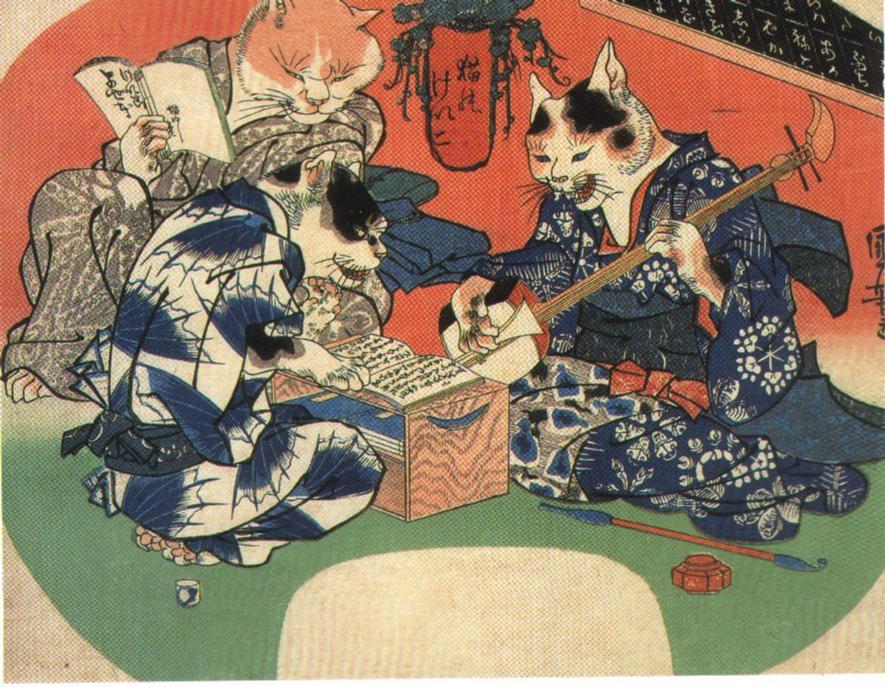
During the Tenpō Reforms, the shogunate forbade depictions of actors, courtesans, and luxury. Ukiyo-e artists like Kuniyoshi responded with wit: they disguised popular figures as cats to avoid direct representation while satisfying public demand. The sheer number of cat prints indicates the animal’s popularity: commoners bought cat pictures, and artists supplied what the market wanted. Anthropomorphized cats conveyed urban humor and playfulness, and sometimes served as vehicles for social satire—evidence of a mature city culture.
Shinto and Cats: The Sacred and the Ambivalent
Across Japan, some shrines enshrine cats as protectors of agriculture and sericulture, stemming from their role as beneficial mousers. At the same time, cats appear in folklore as mysterious beings—such as the bakeneko and nekomata, elderly cats that transform into spirits. They could be associated with ominous powers like manipulating souls. Thus, cats embody a two-sided symbol in Japanese culture: revered and sacred, yet uncanny and fearsome.
Cat Symbolism Across East Asia
The Maneki-Neko spread from Japan across East Asia as a talisman of prosperity. Throughout the region, cats are depicted as both affectionate household companions and enigmatic presences—balancing good fortune with mystery. This duality makes the cat a particularly resonant symbol in East Asian cultures.
Europe (Middle Ages to Renaissance): From Demonization to Reappraisal
The Middle Ages
In medieval Europe, cats’ nocturnal habits and independence led to associations with witches; they became targets of fear and superstition. In illuminated manuscripts and sculpture, cats could symbolize bad omens or chaos. Persecution of cats during plague outbreaks is even thought to have worsened the spread of disease by allowing rats to proliferate.
The Renaissance
As observation and interest in nature grew, cats were re-evaluated as part of the natural world. Leonardo da Vinci’s cat studies show a scientific curiosity about movement and structure. In religious painting, cats sometimes symbolized femininity and sensuality, reflecting new attitudes toward the human body and emotion. In short, the cat mirrored Europe’s shift from superstition to reason, from control to observation.
19th-Century Europe: The Cat as a Domestic Ideal

With industrialization and the rise of the middle-class household, the home came to be seen as a realm of feeling and comfort. Cats were cherished as emotional companions—symbols of domestic happiness and tranquility. Artists such as Henriëtte Ronner-Knip portrayed cats in elegant interiors, expressing feminine grace, maternal affection, and quiet leisure. Anthropologically, this period marks a major shift: animals were no longer primarily tools or divine symbols but partners reflecting human emotion.
20th Century: Cats as Symbols of Individualism and the Psyche
In the modernist era, cats served artists as vehicles for exploring form, feeling, and identity. Paul Klee, Foujita Tsuguharu, and Pablo Picasso used feline grace and solitude to express inner life. For the Surrealists, cats’ capricious, uncanny nature aligned with the unconscious. From the 20th century onward, cats also became metaphors for women’s autonomy and sensuality—the “Catwoman” archetype being a prime example.
21st Century: Cats in Digital Culture
Today, cats are among the most beloved presences on the internet. Memes such as Grumpy Cat, Nyan Cat, and Keyboard Cat embody a postmodern blend of cuteness, irony, and absurdity. Cats also appear frequently in NFT art and street art. Anthropomorphized online, they carry human voices and emotions and function as a totem of shared empathy that connects people across languages and borders. The spread of feline imagery suggests a desire, even in high-tech society, to restore an emotional bond with nature.
Notes on Famous Cat Memes
- Grumpy Cat — An American cat whose permanently “grumpy” expression went viral in 2012. The character appeared in commercials, films, and books, became a registered trademark, and reportedly earned significant revenue.
- Nyan Cat — A 2011 video combining a cat with a pastry body flying through space leaving a rainbow trail, set to daniwellP’s “Nyanyanyanyanyanyanya!” It spawned numerous games and apps.
- Keyboard Cat — Based on footage of “Fatso,” filmed by Charlie Schmidt in 1984 and reposted in 2009 to massive popularity. It became an iconic punchline for fail videos and later appeared widely in ads, games, and films.
Comparing Geography and History — What Cats Mean Around the World

| Era / Region | Symbolic Meaning of Cats | Socio-cultural Role |
|---|---|---|
| Ancient Egypt | Sacred, Protective | Mediator between nature and order |
| East Asia | Harmony, Auspiciousness | Symbol of fortune and balance |
| Medieval Europe | Diabolical, Ominous | Projection of fear and control |
| Renaissance | Object of observation | Reflection of human curiosity |
| 19th Century | Domestic, Sentimental | Emblem of private affection and home |
| 20th Century | Psychological, Sensual | Mirror of inner life and autonomy |
| 21st Century | Playful, Viral | Global cultural totem |
Conclusion

From antiquity to the present, cats have consistently reflected changes in human values and emotions. They have journeyed from sacred guardians to healers of the home—and now to a universal cultural icon. To follow the history of human–feline relations is to ask how we humans wish to live with nature. And to that question, cats may well purr their answer again tomorrow.
